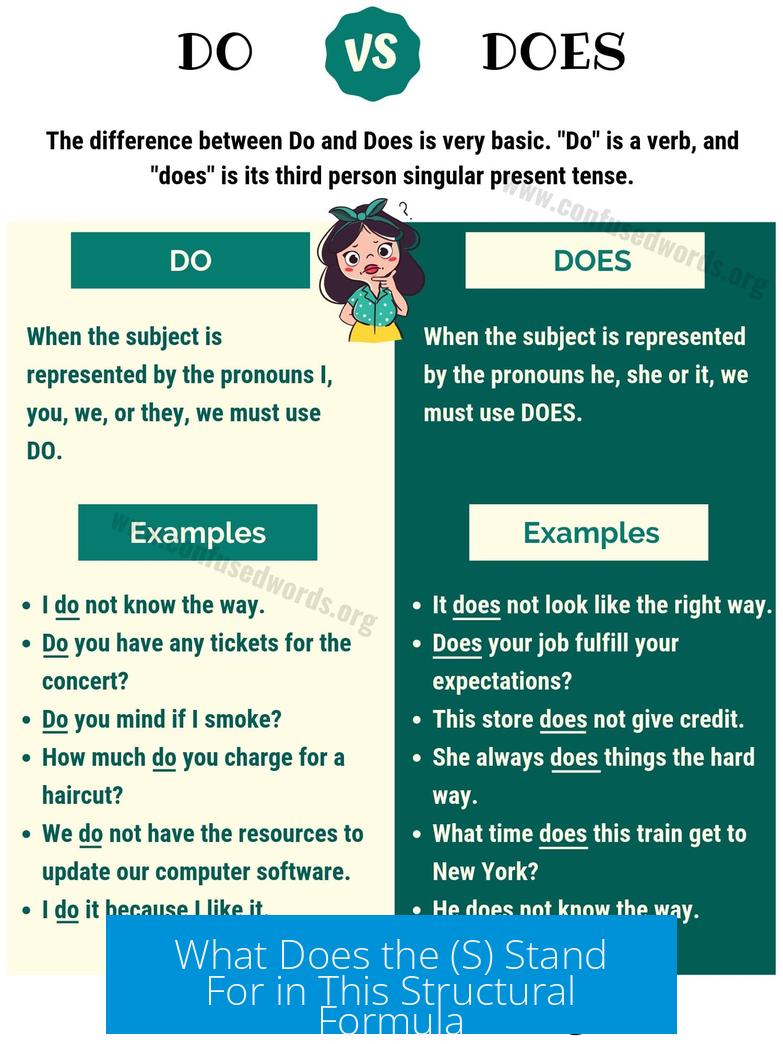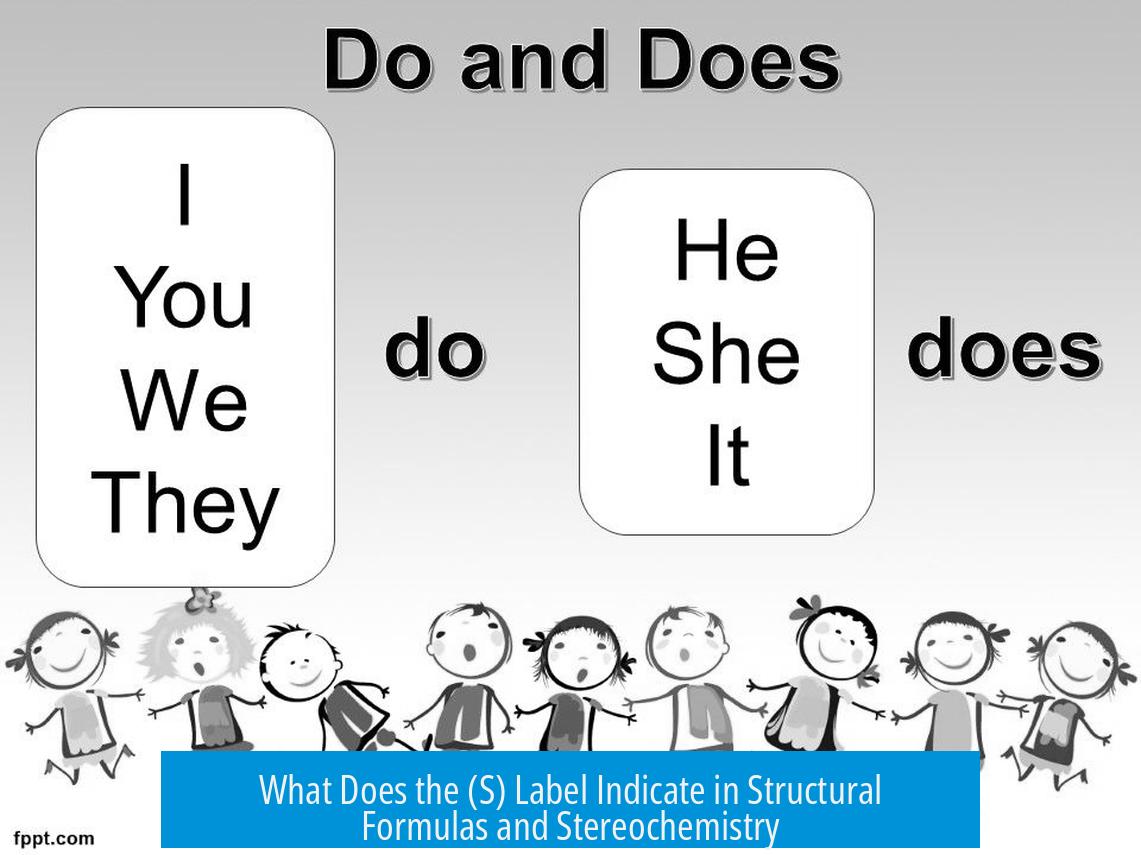What Does the (S) Stand For in This Structural Formula?

The (S) in a structural formula denotes the absolute configuration of a chiral center, indicating that the substituents around the stereocenter are arranged in a counterclockwise order of priority. The letter “S” stands for “sinister,” the Latin word for “left,” representing a left-handed spatial arrangement of groups.
Understanding the (S) Label in Stereochemistry
The (S) designation arises from stereochemistry, the branch of chemistry that studies the three-dimensional arrangement of atoms in molecules. When a carbon atom (or another element) forms bonds with four different groups, it creates a chiral center—an atom whose configuration cannot be superimposed on its mirror image. These two configurations are referred to as enantiomers.
To describe the spatial arrangement, the R/S nomenclature system is applied. It assigns absolute configuration to chiral centers based on the priority of attached groups. The (S) label means the groups’ sequence is counterclockwise when viewed from a specific orientation, whereas (R), standing for “rectus” (Latin for “right”), means clockwise.
The Origin and Meaning of “S”

The letter “S” is derived from the Latin word sinister, meaning “left.” This links the label directly to the direction of the substituents’ sequence around the stereocenter when using the Cahn-Ingold-Prelog priority rules:
- S = Sinister: Left-handed (counterclockwise) configuration
- R = Rectus: Right-handed (clockwise) configuration
This nomenclature is not related to the direction the molecule rotates plane-polarized light (which is described by “+” or “-” signs or “d” and “l” for dextrorotatory and levorotatory). Instead, it is an absolute descriptor based on the molecule’s 3D geometry and atomic priorities.
How to Determine the (S) Configuration
Assigning the (S) or (R) configuration uses the Cahn-Ingold-Prelog (CIP) priority rules:
- Identify the chiral center (typically a carbon with four different substituents).
- Assign priorities (1 highest to 4 lowest) to the substituents attached to the chiral center based on atomic number (higher atomic number = higher priority).
- Orient the molecule so that the lowest priority group (4) points away from the observer.
- Trace the sequence from priority 1 → 2 → 3.
- If this path is counterclockwise, the configuration is (S). If clockwise, the configuration is (R).
This system ensures an unambiguous way to describe stereochemistry across different molecules. For example, if looking down the bond from the chiral center to the group with the lowest priority shows a counterclockwise order, the center receives the (S) label.
Relation Between (S) Configuration and Molecular Chirality
Molecular chirality is key to many chemical and biological processes. The (S) configuration identifies one enantiomer of a chiral molecule, which can have vastly different properties compared to its (R) counterpart:
- The 3D shape defined by (S) or (R) influences how a molecule interacts with biological receptors and enzymes.
- Often, one enantiomer can be therapeutic while the other is less active or harmful.
- Example: Thalidomide’s enantiomers show distinct effects; one treats disease, the other causes birth defects.
Thus, correctly assigning (S) or (R) configuration enables chemists to predict and understand molecular behavior in drug design, synthesis, and analysis.
Distinction From Optical Activity
It is important to distinguish the (S)/(R) system from optical rotation (dextrorotatory or levorotatory), which describes how chiral substances rotate plane-polarized light:
- (S) and (R) indicate absolute spatial arrangement, regardless of optical activity.
- Optical rotation is measured experimentally and reported as (+) or (−), depending on rotation direction.
- For example, an (S) enantiomer may rotate light either clockwise or counterclockwise; the two properties are not directly linked.
Common Confusions and Clarifications
The (S) label can cause misunderstanding due to several reasons:
- It is often confused with the sign of optical rotation (positive or negative).
- The terminology “left” (sinister) might imply rotation direction, yet it strictly refers to priority sequence direction.
- Past terminology like “L” and “D” used alpha-amino acids and sugars classification, which is different from (S)/(R).
Therefore, learning the CIP rules and visually analyzing molecules in three dimensions is necessary to grasp these assignments properly. Computer modeling tools or molecular models help visualize the orientations.
Summary Table: (S) Configuration Essentials
| Aspect | Explanation |
|---|---|
| Definition | Absolute configuration of a chiral center with counterclockwise priority |
| Origin of (S) | Latin “sinister” meaning left |
| Priority Rules | Cahn-Ingold-Prelog system based on atomic numbers |
| Rotation Direction | Counterclockwise sequence when lowest priority group is oriented away |
| Relation to Optical Rotation | Independent of experimental optical rotation (+ or −) |
| Relevance | Defines stereochemistry critical for biological activity and molecular interactions |
Importance in Chemistry and Pharmacology
Knowing whether a molecule is (S) or (R) matters in drug development and synthesis:
- Enantiomers often show different biological activity or toxicity.
- Regulatory agencies require the absolute configuration to ensure safety and efficacy.
- Purification efforts aim to isolate a specific enantiomer, particularly the (S) or (R) form as needed.
The (S) descriptor ensures accurate communication and understanding of molecular structures in scientific literature, patents, and pharmaceutical formulations.
Additional Considerations
In multi-chiral molecules, there can be several stereocenters each assigned (S) or (R) independently. The overall properties depend on the combination of absolute configurations.
Stereochemistry also extends beyond carbon centers to atoms such as sulfur, phosphorus, and metal centers in coordination complexes, where the (S)/(R) designation remains applicable following CIP rules.
Key Takeaways
- (S) denotes the absolute configuration of a chiral center with substituent priorities arranged counterclockwise.
- It stands for sinister, Latin for “left,” contrasting with (R) for “right” (rectus).
- The designation follows the Cahn-Ingold-Prelog priority rules, based on atomic numbers of groups attached to the stereocenter.
- It is a spatial descriptor, independent from optical rotation measurements.
- Correct stereochemical assignment is essential in understanding molecular function, especially for pharmaceuticals.
- Molecular models and careful visualization aid in determining (S) or (R) configurations accurately.
What does the (S) signify in a structural formula?
The (S) indicates the absolute configuration at a chiral center. It shows that the priority of groups around that atom is arranged in a counterclockwise direction.
Why is (S) called “sinister” in stereochemistry?
“S” is short for sinister, a Latin word meaning left. It means the molecule’s stereochemistry is left-handed or counterclockwise when assigning priorities.
How does (S) differ from (R) in molecular structures?
(S) means the groups around the chiral center are ranked counterclockwise, while (R) means clockwise. They represent two possible mirror-image configurations, or enantiomers.
How is the (S) configuration determined for a chiral center?
It depends on the Cahn-Ingold-Prelog priority rules. Groups attached to the chiral atom are ranked by atomic number, then viewed to see if the priority order goes clockwise (R) or counterclockwise (S).
Does (S) tell us about the optical rotation of the molecule?
No, (S) describes the spatial arrangement, not the direction the molecule rotates plane-polarized light. Optical rotation is unrelated to R/S notation and must be measured separately.
Why is knowing (S) configuration important in chemistry and drugs?
The 3D shape affects how molecules interact in the body. Different enantiomers, like (S) and (R), can have very different biological effects, making this designation crucial for safe drug design.





Leave a Comment